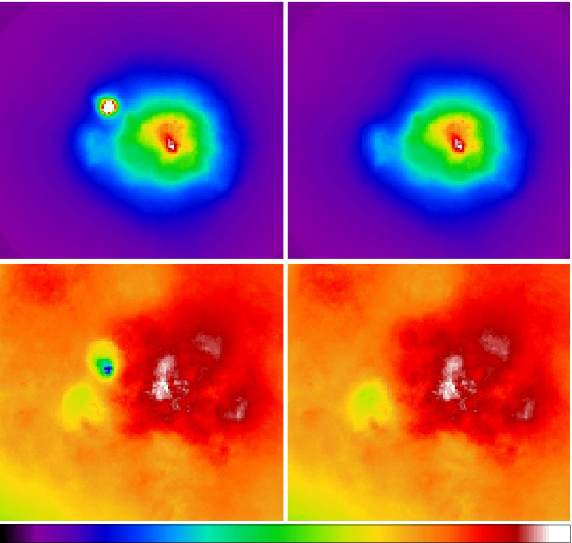February 17, 2016 report
A peek into the merging galaxy cluster Abell 3888

(Phys.org)—Studying substructures of galaxy clusters can reveal important information about the morphology and evolution processes of these gravity-bound groups of galaxies. Optical spectroscopy is very helpful in this matter, capable of unraveling the history of large-scale structure formation in the universe. That's why a team of astronomers from New Zealand conducted a series of spectroscopic observations to peek into the galaxy cluster Abell 3888, unveiling that this cluster is dynamically young and might be an indicator of an ongoing or past merger event. A paper detailing the findings was published online on Feb. 11 on the arXiv pre-print server.
The team, led by Associate Professor Melanie Johnston-Hollitt of the Victoria University of Wellington in New Zealand, has used the AAOmega spectrograph installed on the 3.9-meter Anglo-Australian Telescope (AAT) situated at the Siding Spring Observatory in Australia. Thanks to the spectrograph's 400 fibres covering a two-degree field when projected on sky, it is an excellent instrument for examining the optical substructure in nearby southern clusters.
The researchers carried out their observations in May 2013. They were initially targeting nearly 800 galaxies up to 30' radius from the centre of the cluster. In result, the team detected 254 new redshifts in this region and in combination with previous findings, they determined that Abell 3888, as the main structure, has 71 member galaxies. Importantly, the astronomers were able to identify substructures in the field that were very helpful in unraveling the merging nature of this galaxy cluster.
"The combination of pieces of evidence from the optical analysis, the elongated optical galaxy distribution, and our substructure test which showed that Abell 3888 is bimodal strongly suggests that this cluster has had dynamical interactions and is highly likely to be a young cluster in an active merging state," the paper reads.
Galaxies and galaxy groups come together and merge to form larger units such as galaxy clusters. Cluster merging is believed to be a key parameter in formation and evolution of galaxy clusters. The process is very common and has a significant impact on cluster characteristics such as velocity dispersion, temperature and mass. It often generates clumps of galaxies within the cluster volume. This change in galaxy volumetric density is known as "substructure."
"Substructures may be formed through the infall of individual galaxies or galaxy groups into a relaxed cluster or during the merging of two or more entire galaxy clusters," the researchers wrote in the paper.
Currently, the most robust method to detect merging is the combination of the optical and X-ray substructure analyses of clusters. Therefore, Shakouri and her colleagues underline that results from spectroscopic observations of Abell 3888 are consistent with previous findings from the X-ray studies focused on unveiling morphology of galaxy clusters.
In addition, the team also detected six galaxy over-densities in the field. Three of them were classified as new galaxy clusters.
The researchers concluded that further spectroscopic analysis of Abell 3888 would be useful to further probe its dynamics. They also stressed the need for single slit spectroscopy or more usefully observations with an integral field unit are required to increase the spectroscopic coverage in the cluster core.
"This would allow a more detailed probe of the cluster core and better statistics on the merging populations," the scientists noted.
More information: An Optical Analysis of the Merging Cluster Abell 3888, arXiv:1602.03756 [astro-ph.CO] arxiv.org/abs/1602.03756
Abstract
In this paper we present new AAOmega spectroscopy of 254 galaxies within a 30' radius around Abell 3888. We combine these data with the existing redshifts measured in a one degree radius around the cluster and performed a substructure analysis. We confirm 71 member galaxies within the core of A3888 and determine a new average redshift and velocity dispersion for the cluster of 0.1535 +- 0.0009 and 1181 +- 197 km/s, respectively. The cluster is elongated along an East-West axis and we find the core is bimodal along this axis with two sub-groups of 26 and 41 members detected. Our results suggest that A3888 is a merging system putting to rest the previous conjecture about the morphological status of the cluster derived from X-ray observations. In addition to the results on A3888 we also present six newly detected galaxy over-densities in the field, three of which we classify as new galaxy clusters.
© 2016 Phys.org





















